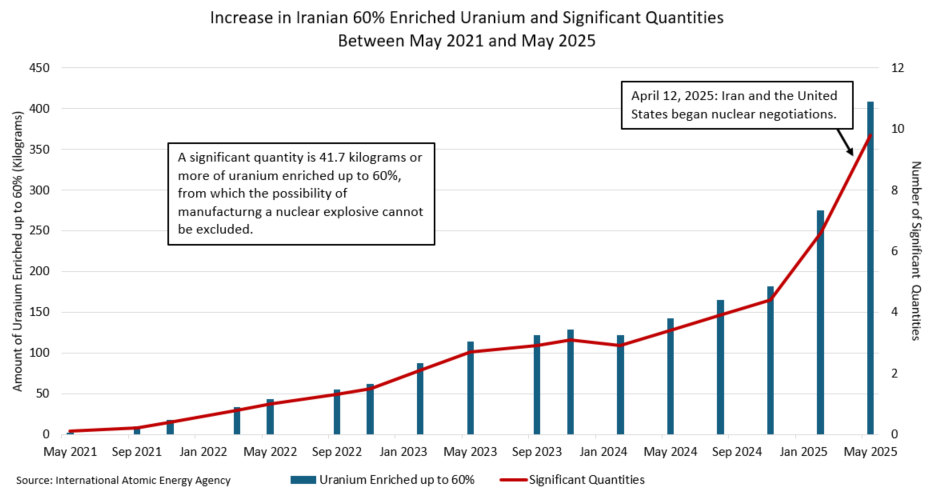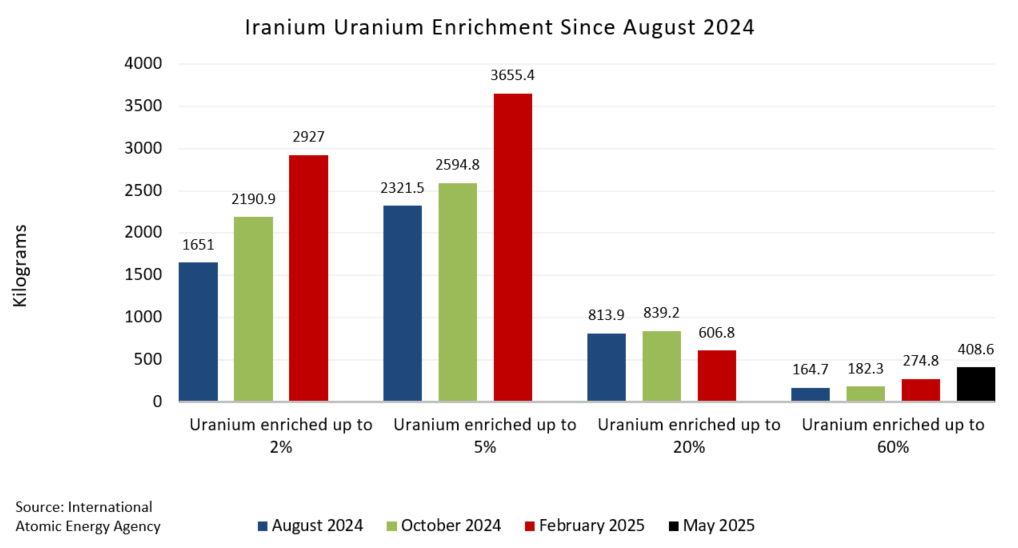Ria Reddy, Ben Rezaei, Katherine Wells, Kelly Campa, Avery Borens, Carolyn Moorman, Johanna Moore, Ben Schmida, Andie Parry, and Annika Ganzeveld
Information Cutoff: 2:00pm ET |
|
Click here to view ISW–CTP's interactive control-of-terrain map of Syria.
Click here to view ISW's complete portfolio of interactive maps. |
|
Iran increased its stockpile of 60 percent enriched uranium by 133.8 kilograms, or 3.2 significant quantities, since February 2025, according to an unreleased International Atomic Energy Agency (IAEA) report. Iran has enough 60 percent enriched uranium, if enriched further, to produce nearly 10 nuclear weapons. The Associated Press reported on May 31 that Iran possesses 408.6 kilograms of uranium enriched up to 60 percent, or 9.8 significant quantities, as of May 17. A significant quantity is the “approximate amount of nuclear material for which the possibility of manufacturing a nuclear explosive device cannot be excluded.” Iran had 274.8 kilograms of uranium enriched up to 60 percent, or 6.6 significant quantities, in February 2025, by comparison. The IAEA report added that Iran’s total stockpile of enriched uranium is 9,247.6 kilograms, which marks a 953.2-kilogram increase since February 2025. The IAEA report does not provide a month-to-month breakdown of Iran's uranium enrichment activity. It is therefore unclear whether Iranian uranium enrichment increased, decreased, or remained the same following the start of the US-Iran nuclear negotiations on April 12. Iran has previously increased its stockpile of enriched uranium to try to gain leverage in negotiations. It is unclear, however, why Iran would pursue rapid enrichment amid the current US-Iran negotiations and potentially increase the risk of snapback sanctions or potential US or Israeli strikes on Iran. The IAEA report comes as Iran has taken other measures to expand its nuclear program in recent months. Iran has installed new cascades of advanced centrifuges at Natanz and Fordow. Iran has also conducted metallurgical testing and computer simulations that could support the production of a nuclear weapon.
Key Takeaways:
- Iranian Nuclear Program: Iran increased its stockpile of 60 percent enriched uranium by 133.8 kilograms, or 3.2 significant quantities, since February 2025, according to an unreleased International Atomic Energy Agency (IAEA) report. Iran has enough 60 percent enriched uranium, if enriched further, to produce nearly 10 nuclear weapons. It is unclear whether Iranian uranium enrichment increased, decreased, or remained the same following the start of the US-Iran nuclear negotiations on April 12. The IAEA separately published a comprehensive report on May 31 that states that Iran’s cooperation with the IAEA has been “less than satisfactory” in “a number of respects.”
- US-Iran Nuclear Negotiations: The United States presented a written nuclear proposal to Iran via Oman on May 31. Unspecified officials told the New York Times on May 31 that the proposal includes the establishment of a regional consortium comprised of Iran, the United States, Saudi Arabia, and other Arab states. Axios similarly reported on May 31 that the proposal includes the establishment of a regional consortium to enrich uranium for civilian purposes. It is unclear if the United States would allow Iran to continue enriching uranium on Iranian soil if it agreed to join a regional consortium. Iran is reportedly planning to reject the US nuclear proposal, which would likely further stall the US-Iran negotiations.
- Iraqi Parliamentary Elections: Iranian-backed Iraqi militia Asaib Ahl al Haq (AAH) is waging a campaign against Popular Mobilization Committee Chairman Faleh al Fayyadh, likely to damage Fayyadh’s electoral prospects in the November 2025 Iraqi parliamentary elections. AAH may calculate that it can damage Fayyadh’s electoral prospects in the upcoming elections by highlighting his alleged ties to Turkey and support for the Ninewa Guards and Kirkuk Shield Brigades.
- Threat to US Forces: Iranian-backed Iraqi militia Kataib Hezbollah threatened to resume its attack campaign against US forces in Iraq in a statement commemorating the death of former Supreme Leader Ruhollah Khomeini on June 2. Kataib Hezbollah threatened that it would inflict “severe blows” on the United States if the United States ”procrastinat[es]” its withdrawal from Iraq.
- Iraqi Militia Funding: Iranian-backed Iraqi militias have exploited loopholes within the Iraqi financial system to commit fraud and obtain funds to support operations since 2023. The Wall Street Journal reported on May 31 that cross-border transactions increased from $50 million to $1.5 billion between January and April 2023 after the US Treasury and New York Federal Reserve took steps in 2022 to curb Iranian money laundering through Iraqi banks.
- Iranian Preparations for Potential US or Israeli Strikes: Financial Times reported on June 1 that Western intelligence and satellite imagery indicate that Iran has repositioned surface-to-air missile launchers, including S-300 air defense systems, near nuclear sites such as Natanz and Fordow. Iranian commanders also continue to inspect air defense sites ahead of a potential Israeli or US strike on Iran.
- Syrian Army Formation: The United States will allow the Syrian transitional government to integrate foreign fighters into the new Syrian army in order to prevent foreign fighters from joining Salafi-jihadi groups in Syria. US Special Envoy to Syria Thomas Barrack told Reuters on June 2 that the United States reached an “understanding” that the Syrian Ministry of Defense (MoD) will integrate foreign fighters into the ranks of the new Syrian army “with transparency.” Unspecified sources close to the Syrian MoD told Reuters that Syrian President Ahmed al Shara and his advisers argued to Western officials that excluding foreign fighters from the army could push them toward groups like al Qaeda or the Islamic State of Iraq and Syria (ISIS). Three unspecified Syrian defense officials said on June 2 that the MoD is planning to integrate 3,500 foreign fighters, including fighters from TIP, into the newly-formed 84th Division.
|
|
Donate online or by sending a check to the Institute for the Study of War at 1400 16th Street NW, Suite #515, Washington, DC, 20036. Please consider including the Institute for the Study of War in your estate plans.
ISW is a tax-exempt organization under section 501(c)(3) of the Internal Revenue Code. Donations are tax-deductible to the extent permitted by law.
The Institute for the Study of War (ISW) is a non-partisan, non-profit, public policy research organization. ISW advances an informed understanding of military affairs through reliable research, trusted analysis, and innovative education. We are committed to improving the nation's ability to execute military operations and respond to emerging threats in order to achieve US strategic objectives. |
|
|
|
|






 [ISW] 러시아의 공세 캠페인 평가, 2025년 6월 3일
[ISW] 러시아의 공세 캠페인 평가, 2025년 6월 3일
 [ISW] 러시아의 공세 캠페인 평가, 2025년 6월 2일
[ISW] 러시아의 공세 캠페인 평가, 2025년 6월 2일